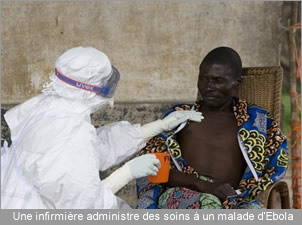Ebola hemorrhagic fever - Uganda (17): (KI)
Archive Number: 20120813.1241762
EBOLA HEMORRHAGIC FEVER - UGANDA (17) (KIBAALAE)
************************************************
A ProMED-mail post
http://www.promedmail.orgProMED-mail is a program of the
International Society for Infectious Diseases
http://www.isid.org
Date: Sun 12 Aug 2012
Source: New Vision (Uganda) [summ., edited]
http://www.newvision.co.ug/news/634018-how-the-deadly-ebola-came-back.html= The outbreak of Ebola [fever] in Kibaale district is still shrouded in mystery 52 days after the 1st patient died. A mother left her 2 month old baby sleeping in a mud and wattle hut and went to her crop garden. On return, she found the baby dead. The baby's left palm had the sign of an animal bite. Neighbours who spoke to Sunday Vision suspected that it could have been a monkey, but no one really saw it. About 300 metres [328 yards] away from the family is a 10-acre [4 ha] forest and there are bushes in between, so it would be possible for a monkey or any other small animal to move unnoticed.
A 15 year old girl who touched the baby's wound, became sick 2 days later, and died on 21 Jun 2012. Eventually, 9 members of the family died but the baby's mother did not become sick. Then the baby's father and a paternal uncle fell sick. According to the national Ebola task force, the 15 year old girl was the 1st patient. However, locals insist she got the disease from the baby. Medical theory indicates that an Ebola [fever] outbreak starts when an infected animal, most likely a monkey or a bat, infects a human being. Through direct contact, s/he then infects other people. However, it is not clear how animals become infected and where the virus hides in the environment before infecting animals.
Critics have blamed the Ministry of Health for taking long to diagnose [ebolavirus infection]. By the time the ministry announced it was Ebola [fever] on 24 Jul 2012, the epidemic had gone on for 37 days, killing 14 people including a clinical officer. The ministry, on the other hand, says the outbreak was confusing because it did not show the typical symptoms [that is, little haemorrhage]. Tests have shown that the current epidemic has been caused by a strain of the virus known as Sudan ebolavirus. However, its signs are different from the previously known Sudan ebolavirus outbreaks.
According to a press statement released by the health ministry last week [week of 6 Aug 2012], the number of people contracting [ebolavirus] had reduced significantly due to increased public awareness. No case has been reported outside Kibaale, says the statement signed by Dr Denis Lwamafa on behalf of the director general of Health Services. By Thu 19 Aug 2012, 190 out of the 408 people being observed after coming in contact with Ebola fever patients had been declared free of the disease after they did not become sick within 21 days, the maximum incubation period. The ward had only 3 ebolavirus infected patients, one of whom was recovering.
But the campaign has not been without challenges and, as Dr Mbonye argues, the Kibaale outbreak should be a lesson. "The government should have an emergency fund for epidemics because every time we are faced with outbreaks, the ministry has to run to cabinet and parliament to ask for funds. This consumes a lot of time as people are dying. At least funds should be earmarked for epidemics annually," said Mbonye. Nearly half the budget for the campaign against [the current ebolavirus outbreak] has come from donors, and officials argue it is disastrous to depend on donors for epidemic responses.
According to Dr Anthony Mbonye, the commissioner for health service and head of community health, it is unusual for an Ebola [fever] patient to bleed after, rather than before death as was the case in Kibaale. The patients had high fever, vomiting, diarrhoea, and stomach aches. Most of them were not bleeding until after death. It was initially mistaken for malaria.
Mbonye says the health ministry is preparing to conduct ecological studies in the area to investigate the cause of the outbreak. It might involve catching monkey, rodents, bats, and other wild animals and testing them for the virus. But we have never understood the exact animal reservoir. In Luweero we slaughtered monkeys and birds in pursuit of the cause but the results were negative," says Mbonye. "What we know is that ebolavirus is highly infectious. If an infected monkey, for instance, ate part of a fruit, you don't need to eat it to catch the virus; you can get infected if you touch it and don't disinfect your hands."
Although the current outbreak is small, it has a big impact on the economy. Already the tourism sector has begun feeling the pinch as some tourists cancel trips for fear of catching the deadly contagious virus.
[byline: Francis Kagolo, Ismael Kasooha]
-- communicated by: ProMED-mail rapporteur Mary Marshall
[At this time ProMED-mail has seen no independent information to verify this account of the early events in the outbreak of Sudan ebolavirus infection in Kibaale.
Kibaale District is a district in Western Uganda. It is named after its principal town where the district headquarters are located. Kibaale can be located on the map of the districts of Uganda at
http://en.wikipedia.org/wiki/Districts_of_Uganda. A HealthMap/ProMED-mail interactive map can be accessed at
http://healthmap.org/r/2Xz8. - Mod.CP]




